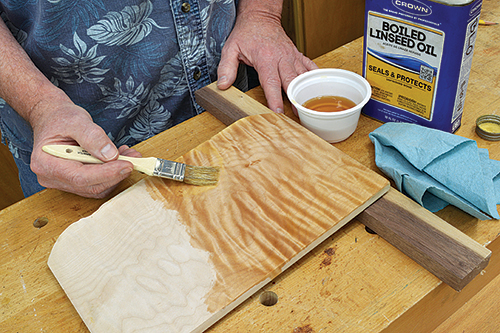
I’ve built a set of drawers in our closet, which includes the facing. I’d like to have the facing match the color of the maple cabinetry in our bathroom through which you enter the closet. When I went to the local Rockler hardware store, they said I may have a problem with “blotchy” areas in Maple so preparing the wood is recommended. I’ve tried several different colors and had the best results was a Gel stain. While the Gel stain gave me very uniform color, it gave me very little color at all. The other stains gave me darker color but not very smooth in appearance. Even if I left it on for 60 minutes. I’ve sanded the wood to 600 grit and then to steel wool to eliminate as many scratches as I can to get the clearest finish I can. Am I over sanding? I’ve seen the archive postings on Pigment vs. Dye stains which I will look into. Any info on the basics of staining would be helpful.
Michael Dresdner: Try layered staining. Stains work in two different ways. Some go into the wood and intensify any characteristics, such as grain patterns, that reside there. Others essentially sit atop the wood. The first type, dyes, are less sensitive to how fine you sanded. The second, pigments, need some rough area to sit in. Speaking for myself, I never sand maple above 220 and rarely above 180 … but that in and of itself will not be a problem.
Start with a water-soluble dye stain (available at Rockler). It will give you deep color, but may bring out characteristics in the wood grain that you want to minimize. Make the stain a few shades lighter than what you ultimately want. Buy a pigmented stain in roughly the same color (the gel stain was probably a pigment) and stain the wood again after the dye stain is dry. Do not seal in between. You will find that the water-soluble dye opened up the pores, colored the wood, and made it more receptive to the second stain, which evened out the color.
As always, do this on sample scrap first.
Rob Johnstone: Staining maple to a dark hue, which is very dense and quite light in color, with an oil based or gel-style product is hard work … and in my opinion, not a good idea. Sanding the wood to 600 grit exacerbated the problem by burnishing the surface of the wood; rendering it even less able to absorb the stain than if you had stopped sanding at 180 or 220 grit. The best solution to your problem is to experiment with wood dye rather than the pigmented stains that you’ve been trying. I recommend Michael Dresdner’s New Wood Finishing Book (Taunton Press) for its discussion of the topic. While I understand your quest to match existing woodwork, this does offer me the opportunity to express my opinion (and you know what that’s worth!) that trying to make birch or maple look like, say … walnut is just dopey. Use walnut lumber and you are way better off. I’m not against enhancing the natural beauty of wood with subtle coloring. Adding red or purple highlights to walnut, enriching cherry lumber’s hue with a wash coat of amber shellac, etc. I just think that too many folks ruin the beauty of a species natural characteristics with excessively dark stains.






